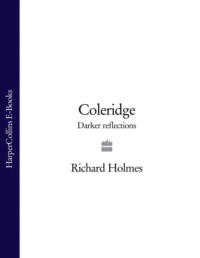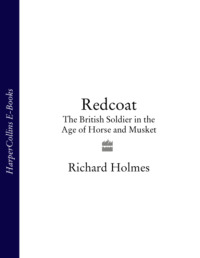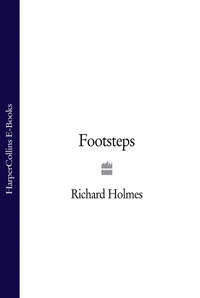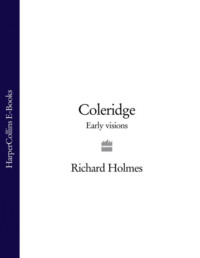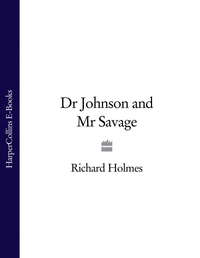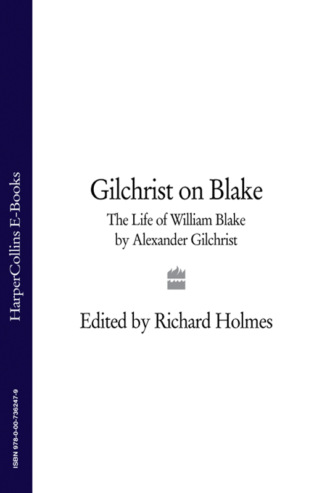
Полная версия
Gilchrist on Blake: The Life of William Blake by Alexander Gilchrist

Gilchrist on Blake
Life of William Blake Pictor Ignotus
by
Alexander Gilchrist
EDITED WITH AN INTRODUCTION BY
RICHARD HOLMES

I assert, for myself, that I do not behold the outward creation, and that to me it is hindrance and not action. ‘What!’ it will be questioned, ‘when the sun rises, do you not see a round disc of fire somewhat like a guinea?’ Oh! no, no! I see an innumerable company of the heavenly host crying ‘Holy, holy, holy is the Lord God Almighty!’ I question not my corporeal eye any more than I would question a window concerning a sight. I look through it, and not with it.
BLAKE.—A Vision of the Last Judgment.
Table of Contents
Cover Page
Title Page
Epigraph
Introduction
Select Chronology
One Preliminary
Two Childhood, 1757-71
Three Engraver’s Apprentice 1771-78 [ÆT. 14-21]
Four A Boy’s Poems 1768-77 [ÆT. 11-20]
Five Student and Lover 1778-82 [ÆT. 21-25]
Six Introduction to the Polite World 1782-84 [ÆT. 24-27]
Seven Struggle and Sorrow 1782-87 [ÆT. 25-30]
Eight Meditation: Notes on Lavater 1788 [ÆT. 30-31]
Nine Poems of Manhood 1788-89 [ÆT. 31-32]
Ten Books of Prophecy 1789-90 [ÆT. 32-33]
Eleven Bookseller Johnson’s 1791-92 [ÆT. 34-35]
Twelve The Gates of Paradise, America, ETC. 1793 [ÆT. 36]
Thirteen The Songs of Experience 1794 [ÆT. 37]
Fourteen Productive Years 1794-95 [ÆT. 37-38]
Fifteen At Work for the Publishers 1795-99 [ÆT. 38-42]
Sixteen A New Life 1799-1800 [ÆT. 42-43]
Seventeen Poet Hayley and Felpham 1800-1801 [ÆT. 43-44]
Eighteen Working Hours 1801-3 [ÆT. 44-46]
Nineteen Trial for High Treason 1803-4 [ÆT. 46-47]
Twenty Adieu to Felpham 1804 [ÆT. 47]
Twenty-One South Molton Street 1804 [ÆT. 47]
Twenty-Two A Keen Employer 1805-7 [ÆT. 48-50]
Twenty-Three Gleams of Patronage 1806-1808 [ÆT. 49-51]
Twenty-Four The Designs to Blair 1804-8 [ÆT. 47-51]
Twenty-Five Appeal to the Public 1808-10 [ÆT. 51-53]
Twenty-Six Engraver Cromek 1807-1812 [ÆT. 50-55]
Twenty-Seven Years of Deepening Neglect 1810-17 [ÆT. 53-60]
Twenty-Eight John Varley and the Visionary Heads, 1818-20 [ÆT. 61-63.]
Twenty-Nine Opinions: Notes on Reynolds 1820 [ÆT. 63]
Thirty Designs to Phillips’ Pastorals 1820-21 [AElig;T. 63-64]
Thirty-One Fountain Court, 1821-25 [ÆT. 64-68]
Thirty-Two Inventions to the Book of Job 1823-25 [ÆT. 66-68]
Thirty-Three Hampstead; and Youthful Disciples, 1825-27 [ÆT. 68-70]
Thirty-Four Personal Details
Thirty-Five Mad or Not Mad
Thirty-Six Declining Health: Designs to Dante 1824-1827 [ÆT 67-70]
Thirty-Seven Last Days, 1827 [ÆT. 69-70]
Thirty-Eight Posthumous 1827-31
Appendix
Further Reading
Index
Classic Biographies By
Copyright
About the Publisher
INTRODUCTION
1
When William Blake died in London in 1827, he was already a forgotten man. He had been living in two-room lodgings in Fountain Court, in the Middle Temple, off Fleet Street. His engraved and hand-painted Songs of Innocence and of Experience, had sold less than twenty copies in thirty years. His Prophetic Books had disappeared almost without trace. A single mysterious poem – The Tyger’ – had reached the anthologies. As a poet – once read in manuscript by Coleridge, Wordsworth and Charles Lamb – he was virtually unknown outside a small circle of disciples, a group of young men who pointedly called themselves The Ancients’. Robert Southey, the Poet Laureate, magnanimously dismissed him ‘a man of great, but undoubtedly insane genius’.
As an artist, his reputation was little better. He was chiefly remembered as a one-time commercial engraver of grimly improving texts: Edward Young’s Night Thoughts, Robert Blair’s The Grave, the dark Biblical drama of the Book of Job, and Dante’s Inferno still unfinished at the time of his death. In 1830 Blake was given a short and gently patronizing entry in Alan Cunningham’s Lives of the Most Eminent British Painters. The illuminations to The Songs of Innocence, and the Book of Job, were mildly admired. The Tyger’ was re-printed as an example of fascinating eccentricity.
But Cunningham damned him with faint praise. Blake was a lovable, minor eccentric: unworldly, self-taught and self-deluded. He produced work that was ‘unmeaning, mystical and extravagant’. He was a man ‘overmastered’ by his own imagination. He confused ‘the spiritual for the corporeal vision’. But for the stabilizing influence of his faithful – but ‘illiterate’ – wife Kate, William Blake would be remembered simply as ‘a madman’.
Three years later, in March 1833, the Monthly Magazine wittily celebrated Blake’s lunacies. ‘Blake was an embodied sublimity. He held converse with Michael Angelo, yea with Moses; not in dreams, but in the placid still hour of the night – alone, awake – with such powers as he possessed in their full vigour…He chatted with Cleopatra, and the Black Prince sat to him for a portrait. He reveled in the past; the gates of the spiritual world were unbarred at his behest, and the great ones of bygone ages, clothed in the flesh they wore on earth, visited his studio.’
Blake was diagnosed as a sufferer of extreme and persistent visual hallucinations, a man who ‘painted from spectres’, and had lost his grasp on reality. ‘His may be deemed the most extraordinary case of spectral illusion that has hitherto occurred. Is it possible that neither Sir Walter Scott, nor Sir David Brewster – the authors of Demonology and Witchcraft and Natural Magic – ever heard of Blake?’
This article had great success, and was copied by the smart Parisian magazine, La Revue Britannique, the following year. The translation was a little hurried, and opened with the assertion that not only was the ‘spectral’ William Blake still alive, but he was actually incarcerated in a London madhouse. The two most celebrated inmates of the madhouse of Bedlam in London are the arsonist Martin, estranged elder brother of the painter John Martin, and William Blake – nicknamed “The Seer”.’
Twenty years after his death, ‘mad’ Blake’s reputation was barely taken seriously at all. A large manuscript collection of his work was offered for private sale by a keeper at the British Museum in 1847. It consisted of a foolscap quarto sketchbook of 58 leaves, packed with Blake’s unpublished poems and drawings. It would now be considered priceless, but then it was sold for a mere ten shillings and sixpence.
The purchaser was Dante Gabriel Rossetti. Vague plans to publish it by the Pre-Raphaelite brotherhood were mooted, and Dante’s brother the critic William Rossetti, expressed an interest. But on examination it was put quietly aside as too difficult and obscure to interest the public. A whole generation had now elapsed, the surviving ‘Ancients’ were indeed growing old, and the memory of ‘mad’ Blake was dwindling to nothing. It is possible that the author of The Tyger’ might have been entirely lost.
Then, thirteen years later, on 1 November 1860, Rossetti wrote to his friend the poet William Allingham with surprising news. ‘A man (one Gilchrist, who lives next door to Carlyle) wrote to me the other day, saying he was writing a Life of Blake, and wanted to see my manuscript by that genius. Was there not some talk of your doing something by way of publishing its contents? I know William thought of doing so, but fancy it might wait long for his efforts…I have not engaged myself in any way to the said Gilchrist on the subject, though I have told him he can see it here if he will give me a day’s notice.’
When the ‘said Gilchrist’ finally visited in March 1861, Rossetti was surprised to encounter a long-haired, dreamy, moon-faced young man who looked rather as if he had stepped out of one of his own Pre-Raphaelite paintings. Alexander Gilchrist was thirty-two, a young writer and art critic, who announced quietly that he had been working on a Life of Blake for the last six years. Indeed, he had already signed a contract with the publisher Macmillan. He did not think William Blake was mad; in fact he thought he was a genius. He was going to transform his reputation, however long it took him, and whatever it cost him.
2
Who was Blake’s unexpected champion? Born in the year after Blake’s death in 1828, Alexander Gilchrist had trained as a barrister in the Middle Temple. Restless in his profession, bookish and not physically strong, but with great determination and independence of mind, Gilchrist sought freedom in magazine journalism and freelance art criticism. From 1849, when he was just twenty-one, he began to write regularly for the Eclectic Review, and quickly made his name as critic and reviewer. He was known for his fresh eye, his jaunty prose style, his meticulous background research, and his highly unorthodox views. He was also a young critic in search of a cause.
In 1850, he produced an outstanding article on the forgotten and unfashionable painter, William Etty. Etty had once been renouned as an exuberant painter of Romantic nudes, both male and female, and erotic scenes from classical history and mythology, such as his Vision of Gyges. Once admired by Regency critics, Victorian taste and propriety had turned against him, and his paintings were scoffingly referred to in Academy circles as ‘Etty’s bumboats’. Gilchrist accepted a speculative commission from a provincial publisher, David Bogue, to write a full-length biography. He undertook to re-establish Etty’s reputation, and turn back the tide of priggish mockery and misunderstanding.
On the strength of the £100 commission, Alexander married his twenty-three year old sweetheart, Anne Burrows, in February 1851. They spent part of their honeymoon researching Etty’s life in York, where the painter had lived and worked. They interviewed his friends, and examined his nude studies and historical pictures, now mostly housed in private collections. This unorthodox nuptial expedition greatly appealed to Anne, who was freethinking in her views, and impatient with the conventions of her respectable Highgate upbringing. She too hoped one day to write.
Their first child was born in December 1851, and the large Etty biography was published in 1855, when Gilchrist was still only twenty-seven. The book, which was studiously written and safely deprived of all illustrations (apparently Bogue lost his nerve at the last moment), caused only a mild scandal in York. But in London it drew wholly unexpected praised from the sixty year-old doyen of biographical writing, Thomas Carlyle. It was written, the Sage announced, ‘in a vigorous, sympathetic, vivacious spirit’, and gave the ‘delineation, actual and intelligible, of a man extremely well-worth knowing’. This rare mark of approval from the author of On Heroes, Hero-Worship and the Heroic in History (1841), confirmed Gilchrist in his new vocation as biographer.
After several visits to Chelsea, Gilchrist established himself as Carlyle’s confidante and to some extent his biographical protege. The Sage had recently published his influential Life of John Sterling (1851), which by sympathetically recounting the career of an apparent failure, indeed a kind of anti-Hero, gave the whole genre a new impulse. It was a time when biography was about to enter a new literary golden age, with John Forster’s Oliver Goldsmith (1854), Mrs Gaskell’s Charlotte Bronte (1857), Samuel Smiles’s Self-Help (1859), G. H. Lewes’s Goethe (1855) and Frederick Martin’s John Clare (1866).
Carlyle noticed that Gilchrist’s dreamy appearance was deceptive: the young lawyer had a capacity for relentless archival research, an almost forensic gift for tracking down rare books and documents. Carlyle was working, with many groans, on his multi-volume Life of Frederick the Great, and soon found Gilchrist bringing him numerous rare bibliographic finds. ‘Beyond doubt you are one of the successfullest hunters up of Old Books now living,’ beamed Carlyle, ‘and one of the politest of obliging men!’
The bookish Gilchrist also took great delight in pursing his open-air researches. With Anne he took long walks in Kent, Dorset, and the Lake District. With Carlyle he wandered after midnight about the backstreets of Westminster, Soho, Lambeth or the City. He had an eye (not unlike the young Dickens) for old houses, forgotten buildings, crooked corners, and disappearing communities. Faced with some old church, said Anne, he would ‘scan every stone’ until it yielded up its ‘quota of history’. Over long evenings of black tea and tobacco, Carlyle encouraged him to talk, speculate, and seek a daring new subject for his pen. A warm, if slightly wary, friendship also grew up between Anne and the older Jane Carlyle.
The subject of William Blake had probably been in Gilchrist’s mind for more than a decade. As a young law student of the Middle Temple, Gilchrist had heard rumours of Blake as the eccentric erstwhile occupant of Fountain Court, which he passed through every day on the way to his legal chambers. He wrote a highly characteristic evocation of this place, its sacred Blakean associations overlaid by mid-Victorian seediness, that eventually appeared in Chapter 31 of his biography.
Fountain Court, unknown by name, perhaps, to many who yet often pass it on their way through a great London artery, is a court lying a little out of the Strand, between it and the river, and approached by a dark narrow opening, or inclined plane, at the corner of Simpson’s Tavern, and nearly opposite Exeter Hall. At one corner of the court, nearest the Strand, stands the Coal Hole Tavern, once the haunt of Edmund Kean and his ‘Wolf Club’ of claquers, still in Blake’s time a resort of the Thespian race; not then promoted to the less admirable notoriety it has, in our days, enjoyed. Now the shrill tinkle of a dilapidate piano, accompaniment to a series of tawdry poses plastiques, wakes the nocturnal echoes, making night hideous in the quiet court where the poet and visionary once lived and designed the Inventions of Job.
Initially Gilchrist knew little of the poetry. As an art critic it was a copy of Blake’s Illustrations to the Book of Job, found at the back of a London printshop, which first caught his eye. He never lost his sense of their astonishing power, and it was Blake’s visual imagination which always remained for Gilchrist the key to his genius. Accordingly, in summer 1855 he decided to write to one of the surviving Ancients, the painter Samuel Palmer, by then aged sixty.
On 23 August 1855 Gilchrist received a long and engaging reply, which he later reprinted entire in Chapter 33 of his biography. While praising Blake’s artistic integrity, Palmer carefully dispelled the notion of Blake’s madness, and replaced it with the figure of a gentle, almost Christ-like sage. ‘He was a man without a mask; his aim was single, his path straight-forwards, and his wants few…His voice and manner were quiet, yet all awake with intellect…He was gentle and affectionate, loving to be with little children, and to talk about them. That is heaven,’ he said to a friend, leading him to a window, and pointing to a group of them at play.’
At the same time Palmer hinted at a prophet from the Old Testament, rather than the New: a formidable Blake who could be highly ‘expressive’ and emotional, ‘quivering with feeling’, capable of deep anger, and with a flashing glance that could be ‘terrible’ towards his enemies. ‘Cunning and falsehood quailed under it.’ He summed up these contradictions with a painterly example from the Italian Renaissance. ‘His ideal home was with Fra Angelico: a little later he might have been a reformer, but after the fashion of Savonarola.’ Gilchrist was captivated, and he and Palmer became fast friends.
A year later in 1856, the Gilchrist family moved in next to the Carlyles at No. 6 Cheyne Row. The pursuit of Blake’s trail through London galleries, local museums, antique bookshops, and private collections now began in earnest. Gilchrist purchased Blake prints, and borrowed what he could not buy. Anne started her own collection of Blake’s watercolours. Together they tracked down Blake’s various lodgings and workshops north and south of the river, in Soho and Lambeth, and meticulously researched his three year sojourn at Felpham, by the sea in Sussex.
Having established friendly contact with the affable Samuel Palmer, Gilchrist moved on to the other surviving Ancients. They were not all so easy to deal with. The painter John Linnell, was helpful but bossy, suggesting the possibilities of a collaboration. He had eleven precious letters from Blake, written at the very end of his life. The sculptor Frederick Tatham, having written his own private Memoir, and taken to religion, was strange and touchy. The artist George Richmond (only fifteen when he met Blake) was now a well-meaning but gushing middle-aged raconteur.
Gilchrist engaged them in correspondence and interviewed them where he could, minutely compiling anecdotes and stories, trying to sift the true from the apocryphal. He talked to Francis Oliver Finch and Flaxman’s younger sister Maria Denman. He was particularly interested in the relations between Blake and his wife Catherine. Original letters from Blake were the one thing Gilchrist found it almost impossible to discover, apart from Linnell’s.
Gilchrist’s greatest diplomatic triumph was to pierce the peppery reserve of the retired journalist, Henry Crabb Robinson, then in his eighties. Robinson – once the intimate friend of Wordsworth, Coleridge and Lamb – had kept extensive diary accounts of the whole Romantic circle during his time. They were admiring, but sceptical and extremely shrewd. In 1811 he had published a rare appreciation of Blake’s work in a German magazine published in Hamburg: ‘William Blake: Artist, Poet, and Religious Dreamer’. Moreover, his unpublished Journals for 1825-7 contained a unique series of interviews with the older Blake. Robinson paid particular attention to the question of Blake’s visions, the logic (or otherwise) of his explanations, and the significance of his eccentricities. Gilchrist managed to obtain all this material, and use it with brilliant effect in Chapter 36.
In the winter of 1859, Gilchrist submitted an outline draft of his Life of Blake to the publisher Macmillan. He was offered an £150 contract, and an advance on research expenses of £20. Compared with the Etty commission, these terms marked a small but not very generous increase. After all, this was a time when popular biographies by Mrs Gaskell and John Forster were being commissioned for well over £1,000. But of course Blake’s name was still worth nothing. Undeterred, Gilchrist worked on through 1860, continuing to support his family with freelance journalism. But it must have seemed an increasingly quixotic venture.
In March 1861, he finally met Dante Gabriel Rossetti, and the pace of research increased still further. The Blake manuscript notebook, purchased over fourteen years before, was at last revealed. Over several later meetings at the Cheshire Cheese tavern, in Fleet Street, the new poems and drawings were discussed. Gilchrist quickly passed muster with the pre-Raphaelite brotherhood, all of whom were suddenly excited by the prospect of the forthcoming book Rossetti’s friendship also brought him into contact with Swinburne, who now discovered a passion for Blake.
Most enthusiastic of all was Dante Gabriel’s brother, the art critic William Michael Rossetti, who encouraged Gilchrist to think in terms of an even more ambitious project. After the biography perhaps he could edit a companion volume of Blake’s poems and a catalogue of his art work? Spurred on by these late supporters, Gilchrist promised Macmillan to deliver the completed biography by spring 1862.
But after six years, the work was now close to exhausting him. Money was short, and by now the Gilchrists had four children. Gilchrist’s constitution, never strong, began to fail. He was frequently ill and depressed, harassed by his weekly art reviews. Sometimes he collapsed, unable to work on Blake for days on end. It was in this growing professional crisis that Anne Gilchrist began quietly to assert herself.
Anne had probably been working as Alexander’s part-time research assistant ever since the Etty days. But now she became his full-time amanuensis. She took dictation, copied Blake’s manuscripts, checked facts and dates at the British Museum, and prepared an index. She admired Gilchrist’s perfectionism, always pursuing one more source or reference. But sometimes she felt he would never complete the book at all.
Nonetheless, by late summer 1861, Gilchrist told Macmillan that he had a draft of the whole biography. Although he was continually slipping in extra materials and anecdotes, the basic structure of the book was secure. It was lucidly organized in thirty-eight short chapters, and he was ready to start sending it in batches to the printer, for setting up in proof. This was the usual procedure for a large book.
Macmillan was delighted and urged him to begin. Accordingly, Gilchrist sent the first eight chapters to the printers in September 1861, taking Blake’s Life up to the Poetic Sketches and the ‘Notes on Lavater’ made when Blake had just turned thirty. He promised to send in the next batch by November, with the aim of having the complete work in proof by the following spring. He was under great pressure, but believed that with Anne’s help he could just about fulfil his deadlines.
On 20 November 1861, Gilchrist wrote to his publisher that he had been unable to send the next ‘big mass of copy, consisting of the next dozen or so chapters (taking Blake up to forty and his most productive years). He explained that ‘domestic troubles have during the last month stood in the way’. For six weeks his eldest daughter, seven year old Beatrice, had been lying dangerously ill at Cheyne Row with scarlet fever. His wife Anne had insisted on a ‘rigid quarantine’, remaining alone in the child’s sickroom to carry out all the nursing herself. There was great fear of infection. Gilchrist was only allowed in once an evening, to make up the fire, while Anne stood back by the window. Meanwhile, he tried to look after the other three young children with the help of one (frequently drunk) domestic.
At the end of his letter, Gilchrist unburdened himself to his publisher.
We have been in great misery at times, aggravated by our having a doctor in whom we had not implicit confidence…My wife has during all this time been confined to the sickroom, without help!…Of hired nurses we have a horror, our friends have mostly children and others regard for whom makes them dread crossing the threshold of a scarlatina infected house. Forgive this closing matter.
Yours faithfully,
Alexander Gilchrist.


